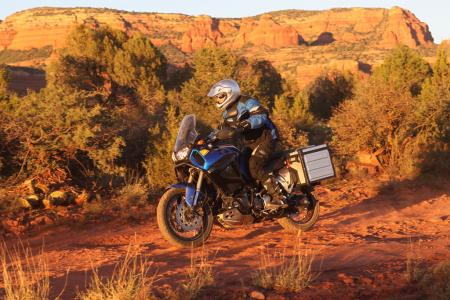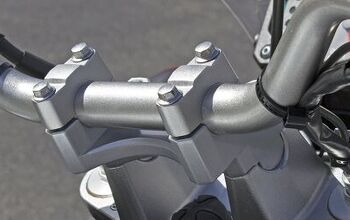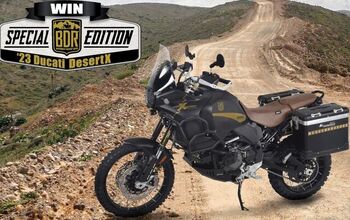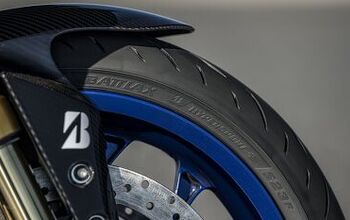2012 Yamaha Super Tenere Review - Motorcycle.com
BMW’s GS juggernaut finally becomes impossible for the Japanese to ignore. Yamaha’s Super Ténéré, an adventure-tourer with a 1200cc twin-cylinder engine, is set to go head to head against the iconic R1200GS when it arrives in America next spring.
Yamaha’s big A-T actually has its own off-road legacy. A single-cylinder Ténéré (no super) enduro first debuted back in 1983. The Ténéré went Super in 1989 when the twin-cylinder XTZ750 debuted in the European market, and it went on to win the grueling Paris/Dakar rally six times. Hence the name Ténéré (say ten-eh-ray), which is a region in the Sahara desert traversed in the P/D rally.
This new Super Ténéré was introduced in Europe earlier this year, and Yamaha recently announced it would be coming to America as a 2012 model. If the 750cc parallel-Twin XTZ was a Super Ténéré, this new model might well be called the Super Duper Ténéré, as it has a 450cc displacement advantage.
The dual-purpose category, although just 6% of the total U.S. market, has shown steady growth since 2005, primarily in the 651cc-and-up segment that was primed by BMW’s R1200GS. The new Super-10 wants a slice of that lucrative market pie.
And after bashing Yamaha’s big trailie around the roads and deserts of Arizona for a couple of days, we found the Ténéré to be a good match for the dominating GS.
Key among the Super-10’s attributes is the features-per-dollar quotient. Its $13,900 base MSRP includes traction control, antilock brakes, dual-mode ride-by-wire mapping, tubeless spoked wheels and hand guards. In comparison, the rarely seen base version of the BMW retails for $14,950 but does without ABS or traction control or hand guards. BMW’s optional “Standard Package” includes ABS, hand guards and on-board computer but retails for $16,935. Spoked wheels are a $500 upgrade, and traction control is another $400.
"...we found the Ténéré to be a good match for the dominating GS."
Although no OEM will likely build a horizontally opposed Twin like the BMW’s Boxer motor, Yamaha has built a distinct but reasonable facsimile. Its Twin is rated at 108.5 crankshaft horsepower, nearly identical to the 110 ponies claimed for the GS.
But the cylinder arrangement of Ténéré’s inline-Twin stands apart. It uses a slightly smaller bore (98mm vs. 101mm) and longer stroke to yield 1199cc (the 1200GS displaces an actual 1170cc). It uses a 270-degree crankpin offset, which has cylinder 2 firing 270 degrees after cylinder 1, then cylinder 1 firing again 450 degrees later. This uneven firing order is said to improve a tire’s grip on slippery surfaces and also has the side benefit of creating an exhaust note very similar to that of a V-Twin.
This uneven firing order creates a lot of vibration, so the Ténéré’s motor is equipped with twin counterbalancers to smooth things out. The balance shaft at the front of the cylinders doubles as the water pump drive. A dry-sump oil system helps the engine be mounted as low as possible so it can be placed optimally in the steel frame. A side-mount radiator allows the engine to be placed further forward, resulting in 50.5% of the bike’s weight to be on the front wheel.
Air is mixed with fuel inside 46mm throttle bodies with 12-hole injectors, firing inside twin-plug cylinder heads like the GS. A ride-by-wire throttle makes possible the traction-control system that has two settings and can also be disabled. It also allows switching maps from a softer Touring setting to a more aggressive Sport mode via a button on the right-side switchgear.
Ears are greeted with a pleasingly deep exhaust sound from a big muffler hidden along the bike’s left side. Its note is similar to a 90-degree V-Twin’s but with hints of the R1’s crossplane-Four and single-cylinder thumps.
"Ears are greeted with a pleasingly deep exhaust sound..."
A four-position clutch lever requires a moderately firm pull to actuate the burly clutch pack consisting of 9 friction plates. Shift action is pleasingly light and positive, and power is transferred to the rear wheel via a shaft to a hypoid gear-set on the rear wheel. The stronger hypoid design allows smaller gears than a spiral-bevel arrangement, which Yamaha says is 10% tidier. However, there is a price to be paid for the hypoid arrangement – gear whine, which is especially noticeable around 60 mph.
A cast-aluminum swingarm actuates a shock hydraulically adjustable for spring preload and rebound damping, just like the GS. Both adjustments require no tools. Like all shaft-driven motorcycles, the rear suspension kicks back over bumps while accelerating.
Rear-suspension travel is 7.5 inches, the same as in the 43mm inverted fork. Yamaha one-ups the BMW by having fork adjustments for compression and rebound damping plus preload. However, the Ténéré isn’t available with anything like BMW’s optional push-button Electronic Suspension Adjustment.
Whether on the street or in the dirt, the Ténéré’s suspension delivers action typical of its conventional design, as opposed to BMW’s interesting but oddball Telelever front end. On paved surfaces, the Yamaha’s long-travel suspenders nicely suck up bumps that would have R1 riders wincing. And it also performs competently on every dirt terrain we sampled, from blasting at 80-plus-mph on groomed dirt roads to hammering over rock-strewn canyon fireroads.
Aiding the Super-10’s high-speed stability is a somewhat lazy rake angle of 28.0 degrees with 126mm of trail. Turn-in response is nice and neutral even if not especially quick – a GS (or Multistrada) requires considerably less effort to crank into a corner.
Tire sizes are the same as used on the R1200GS (110/80-19 in front; 150/70-17 out back), sourced from either Bridgestone or Metzeler in a tubeless design made possible by cross-spoke wheels using a raised rim center section so the spokes don’t reach into the wheel’s interior and release air.
Our test mules were fitted with ’Stone Battle Wing tires developed especially for the Ténéré, using what seem to be deeper tread grooves than off-the-shelf ’Wings to deliver surprisingly good traction in the dirt as long as it isn’t thick and loose like sand. Considering the street-biased nature of most adventure-touring riders, we consider the ‘Wings to be an excellent tire compromise.
Yamaha’s traction-control system provided seat-of-the-pants data for the efficacy of the tires. Toggled into the least intrusive TC mode via a button on the left side of the instrument pod, the Ténéré’s rear tire hooked up well enough in the dirt to keep the TC intervention (indicated by an amber light on the gauges) from cutting in too often.
The TC2 setting allows some sliding before ignition timing and fuel are throttled back to regain grip, and we were pleased to note the intervention was never harsh – the engine never fell flat on its face but instead modulated output rather subtly. The TC1 setting is more intrusive and would best be used only in the slickest of conditions.
Other rider aids lie in the braking system. In addition to standard antilock control, the Ténéré is equipped with Yamaha’s Unified Brake System that links the rear brake to the front lever, helping limit chassis pitching during hard braking that is typical of bikes with long-travel front suspension.
A pull of the brake lever actuates a pump under the seat to apply rear-brake pressure, and the system is smart enough to automatically apply more rear brake when the bike is loaded with the extra weight of a passenger (based on lever pressure) and when the deceleration rate is high. The back of your helmet and the front of your passenger’s will appreciate less bonking when braking, and the UBS operates seamlessly with a solo rider.
A pair of 4-piston monoblock calipers clamp on 310mm wave rotors up front, while a single-piston rear caliper bites on a 282mm wave-style disc. Feedback is quite good through the levers. A 32-bit ECU samples wheel-speed and other data every 1000th of a second, and these tight parameters result in an ABS system that doesn’t kick in easily and quickly reapplies the brakes for minimal freewheeling sensations.
However, we think it’s an enduro-bike faux pas to not have the ability to turn off the ABS system in off-road conditions, especially during hill descents in slippery conditions, when a locked back wheel offers greater deceleration than the on-and-off effect of ABS intervention.
BMW’s ABS system can be disabled, and so can the Multistrada’s, so we’ll have to give Yamaha a demerit point for not giving its riders that option. Yamaha’s ABS isn’t bad in the dirt and much better than earlier antilock systems, but hardcore dirt riders will wish for an off switch.
A little web searching reveals a simple way to disable the ABS, which we only discovered after we rode it. Just put the Tenere on its centerstand and run the bike in gear for a bit. This creates an error signal for the ABS system, so it shuts itself off. An ABS error code light illuminates on the instruments, and a rider is now free to lock up and slide the back tire with impunity!
The Ténéré’s engine boasts a wide and torquey powerband, but considering the GS was obviously in Yamaha’s crosshairs, it was a little surprising to find the Super-10’s engine to be not superior to the Boxer. Seat-of-the pants impressions are of a motor not quite able to tractor away at low revs as the Beemer, and yet it also doesn’t have the top-end lunge expected of such a high-tech powerplant.
Motor Cycle News, a UK-based bike rag, strapped both bikes to a dyno, and it discovered remarkably similar powerbands up until 6000 rpm when the Boxer takes over with a stronger surge up top. The Ténéré peaked at 90.3 hp at rear wheel vs. 99.6 hp for the GS. The Beemer’s stronger engine is allied by its 30-some less pounds to handily beat the Ténéré in dragstrip, roll-on and top-speed performances.
Yamaha claims a curb weight of 575 lbs with its 6.1-gallon tank filled (mostly carried low and between rider’s legs), and MCN’s GS scaled in at 544 lbs with its smaller 5.3-gallon tank topped off.
Despite the deficit in engine performance, the Ténéré is nonetheless an appealing adventure-tourer. It has a satisfying midrange surge and is capable of exceeding 130 mph. Throttle response is quite smooth, even in the Sport setting, and engine vibration is a non-issue. An overdriven sixth gear helps supply a relaxed highway cruise.
The Ténéré’s riding position is very roomy, with tall riders enjoying an extra inch of legroom with its adjustable gripper-type seat set to its highest (34.3 inches) position. An optional low saddle ($239.95) reduces seat height by 1.4 inches to a more easily manageable 31.9 inches in its lowest position but offers significantly reduced padding and, hence, comfort. Its tapered handlebar isn’t too wide and suited riders of all sizes, making it comfortable when sitting and when standing during off-road work. Clever footpegs feature a rubber center section that compresses when standing to set boot soles on the pegs’ clawed outer edges for secure grip.
Protection from the elements is quite good. The standard windscreen deflects enough air to allow for faceshield-up riding with minimal buffeting, and the hand guards and pods around the side of the engine provide augmented wind protection for legs. The windshield adjusts to two heights, but unlike the GS’s hand-turnable knobs, the Ténéré requires removing four screws. Enhanced wind protection is available from an accessory windscreen 2.4 inches taller and adjustable over 3 positions, retailing for $119.95. Side wind deflectors made from 4mm polycarbonate are also optional ($79.95).
A rear luggage rack is standard equipment, and it can be expanded by removing the pillion seat to reveal a flat surface to strap down large items. The rear carrier also serves as a mount for an accessory cargo box ($369.95) big enough (30 liters) to hold a full-face helmet.
Greater stowage capacity is offered by optional saddlebags with 61 liters of combined capacity, and all bags can be keyed to the ignition key. They are built around rugged injection-molded nylon frames with aluminum skins and retail for $1089.85 including a mounting kit. We mostly liked them, but the lid latches are finicky and need to be firmly pressed shut to close properly. I wasn’t the only one at the launch who rode away mistakenly thinking the bags were latched.
The instruments include good stuff like an analog tach (with 8000-rpm redline) next to an LCD info screen that includes speed, drive modes, clock, dual tripmeters, average and instant fuel consumption and air temperature. A fuel tripmeter counts up the miles since switching to the 1.0-gallon reserve, but the instruments lack a range-to-empty feature and a gear-position indicator. A single DC power plug resides beside the gauges.
Some other optional equipment might be considered necessities for those who are serious off-roaders. Key among them is a bash plate to protect the header pipes and oil filter that are otherwise vulnerable to damage – since the engine is mounted as a stressed member, there are no lower frame rails to offer protection, and only a small plastic guard is fitted as stock. The Yamaha accessory skid plate ($199.95) is constructed of 3mm thick aluminum which appears to be quite sturdy, suffering without damage several big rock hits during our ride.
Your globe-trotting adventures should also be accompanied by the optional crash bars that will protect the side-mounted radiator and other stuff you don’t want broken in a spill. Consider the powder-coated steel cage ($449.95) to be proactive roadside insurance.
Heated grips are another nice option that matches up to BMW’s GS, and they retail for $399.95. Also like BMW, Yamaha has combined several accessories into three optional packages, all of which include a GoPro Hero onboard camera.
The X-Country Terrain package includes the crash bars, skid plate and a polycarbonate headlight protector for $749.95. The Comfort & Convenience bundle includes the top case and liner, heated grips, tall windscreen and wind deflector kit for $1,019.75. At the upper end of the price scale is the Adventure Touring Kit for $1,519.60 that includes saddlebags and bag liners, a tank bag, tall windshield and wind deflector kit.
Conclusion
Yamaha’s Super Ténéré brings a worthy foe to the adventure-touring class by virtue of its versatile set of capabilities. It’s one of the rare motorcycles that can easily knock out 500-plus miles of highway travel in a day and also allow exploration of uncharted and unpaved trails off the beaten path. But so does BMW’s R1200GS and GS Adventure, a thoroughly developed all-terrain vehicle that has become a class icon.That the Ténéré mostly matches the formidable GS is no small feat, and that it accomplishes this at a price thousands of dollars less than its German rival makes it a real player in this market.
If you want a Ténéré of your own, you’ll need to put down a $500 deposit to reserve your bike through Yamaha’s Pre-Delivery Deposit Program, the same as used for the FJR1300 and V-Max. Pre-orders close on March 31, 2011. Deliveries begin in May.
Related Reading
2012 Yamaha Super Tenere Preview
2010 Yamaha Super Tenere unveiled
INTERMOT 2010: Yamaha Worldcrosser Concept
Yamaha donating 5 Super Teneres to charity
2010 BMW R1200GS and GS Adventure Review
2010 Ducati Multistrada Review
2010 Ducati Multistrada vs. BMW R1200GS
2008 Yamaha XT660Z Tenere Review
2008 BMW R1200GS Review
2005 Adventure Touring Comparo
2005 BMW R1200GS Review
2005 Yamaha XT660R Review
Ride Report: 2000 BMW R1150GS
1996 Yamaha TDM 850 Review
More by Kevin Duke










































Comments
Join the conversation